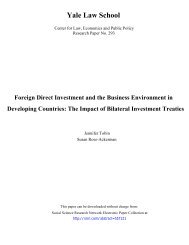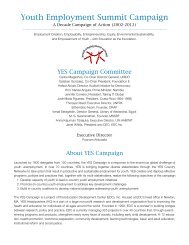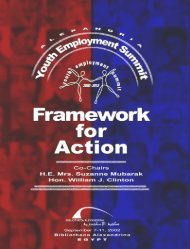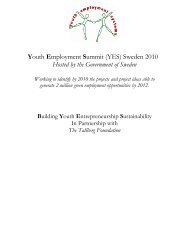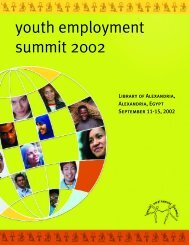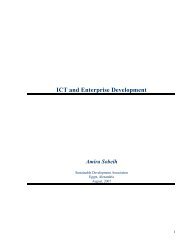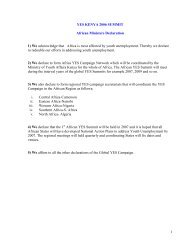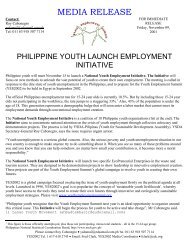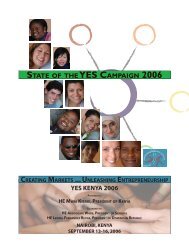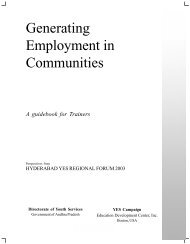EDC's Work in Southeast Asia - Youth Entrepreneurship and ...
EDC's Work in Southeast Asia - Youth Entrepreneurship and ...
EDC's Work in Southeast Asia - Youth Entrepreneurship and ...
You also want an ePaper? Increase the reach of your titles
YUMPU automatically turns print PDFs into web optimized ePapers that Google loves.
TABLE OF CONTENTSAbout EDC …………………………………………………………………………………………….. 1Current <strong>and</strong> Recent EDC Projects <strong>in</strong> <strong>Southeast</strong> <strong>Asia</strong> …………………………… 3Feature Articles About EDC’s <strong>Work</strong> <strong>in</strong> <strong>Southeast</strong> <strong>Asia</strong> …………………………. 7
ABOUT EDC1
For more than four decades EDC has been a pioneer, build<strong>in</strong>g bridges between research, policy, <strong>and</strong>practice. Our award-w<strong>in</strong>n<strong>in</strong>g programs <strong>and</strong> products, developed <strong>in</strong> collaboration with partners aroundthe globe, consistently advance learn<strong>in</strong>g <strong>and</strong> healthy development for <strong>in</strong>dividuals of all ages. Today,EDC manages 325 projects <strong>in</strong> 40 countries. Our work strengthens nearly every facet of society,<strong>in</strong>clud<strong>in</strong>g early child development, K-12 education, health promotion, workforce preparation,community development, learn<strong>in</strong>g technologies, basic <strong>and</strong> adult education, <strong>in</strong>stitutional reform, <strong>and</strong>social justice.As a nongovernmental organization (NGO), EDC’s work is supported through grants <strong>and</strong> contractsfrom a variety of sources, <strong>in</strong>clud<strong>in</strong>g government agencies around the globe, private foundations,nonprofit organizations, universities, <strong>and</strong> corporations. As a publicly supported, publicly accountableorganization, we have a special obligation to carry out work of the highest quality <strong>and</strong> <strong>in</strong>tegrity.Our ApproachProjects at EDC address critical challenges around the world <strong>in</strong> education, health, work, technology<strong>and</strong> human rights. While the issues we address are diverse, all that we do is united by our convictionthat learn<strong>in</strong>g is the liberat<strong>in</strong>g force <strong>in</strong> human development. We are committed to education that buildsknowledge <strong>and</strong> skill, makes possible a deeper underst<strong>and</strong><strong>in</strong>g of the world, <strong>and</strong> engages learners asactive, problem-solv<strong>in</strong>g participants.How Do We Inspire Susta<strong>in</strong>able Change Around the World?We bridge research <strong>and</strong> practice.EDC’s <strong>in</strong>novative solutions comb<strong>in</strong>e the creativity <strong>and</strong> rigor of research with the realities of practicalexperience. Each project grows out of current knowledge <strong>in</strong> the field, <strong>and</strong> each new tool or approach is<strong>in</strong>formed by extensive pilot-test<strong>in</strong>g <strong>and</strong> evaluation.We pursue comprehensive solutions.We have learned that our work cannot succeed <strong>in</strong> isolation. It is not enough, for example, to confrontsubstance abuse or violence without address<strong>in</strong>g their causes, or to focus on academic skills whileignor<strong>in</strong>g children’s health <strong>and</strong> the conditions of the communities <strong>in</strong> which they live. The problems weare work<strong>in</strong>g on are systemic <strong>and</strong> complex. We strive to focus simultaneously on the <strong>in</strong>dividual piecesof the puzzle <strong>and</strong> the puzzle as a whole.We collaborate.Start<strong>in</strong>g with our first physics curriculum, PSSC Physics, EDC has specialized <strong>in</strong> foster<strong>in</strong>g collaborationamong people with diverse skills <strong>and</strong> viewpo<strong>in</strong>ts. We believe that people work<strong>in</strong>g effectively <strong>in</strong> groupsare often capable of greater vision <strong>and</strong> creativity than <strong>in</strong>dividuals work<strong>in</strong>g alone. Internally, EDC is acommunity of scientists <strong>and</strong> mathematicians, health professionals <strong>and</strong> health educators, teachers,adm<strong>in</strong>istrators, <strong>and</strong> community organizers, artists, writers, <strong>and</strong> researchers. Externally, we buildcollaborations across countries, cultures, generations, classes, <strong>and</strong> professions.We focus on questions that matter <strong>in</strong> people’s lives.At EDC, we believe that learn<strong>in</strong>g beg<strong>in</strong>s with questions: a teacher want<strong>in</strong>g to know a new way to solvea mathematics problem; a doctor wonder<strong>in</strong>g how to ease the transition for the family of a dy<strong>in</strong>gpatient; a teenager want<strong>in</strong>g to know why school matters <strong>in</strong> one’s life <strong>and</strong> career; a pr<strong>in</strong>cipal search<strong>in</strong>gfor better ways to meet the needs of students with disabilities; a mother consider<strong>in</strong>g whether tobreastfeed. Over the decades, EDC’s projects have helped people raise <strong>and</strong> explore questions ofimportance <strong>in</strong> their lives <strong>and</strong> develop responses that address their strengths, needs, <strong>and</strong> concerns.2
EDC PROJECTS IN SOUTHEAST ASIA(as of 11/15/03)3
dot-EDU (Digital Opportunity through Technology <strong>and</strong> CommunicationPartnerships-Learn<strong>in</strong>g Systems)A Project of: International Education Systems >> Multichannel Learn<strong>in</strong>g CenterDuration: 2001–2006Director: William WrightFunder: U.S. Agency for International DevelopmentPartner: Academy for Educational DevelopmentProject Web site: www.dot-edu.org/dot-EDU <strong>in</strong>itiatives help USAID missions worldwide br<strong>in</strong>g digital opportunities to learn<strong>in</strong>g environments<strong>in</strong> countries suffer<strong>in</strong>g the effects of civil unrest, natural disasters, <strong>and</strong> HIV/AIDS. Project activities seekto strengthen quality, exp<strong>and</strong> access, <strong>and</strong> enhance the equity of programs <strong>in</strong> basic education, teachertra<strong>in</strong><strong>in</strong>g, <strong>and</strong> higher education through <strong>in</strong>formation <strong>and</strong> communication technologies (ICT). The typesof technology solutions adopted by dot-EDU <strong>in</strong>clude <strong>in</strong>teractive radio <strong>in</strong>struction, on-l<strong>in</strong>e learn<strong>in</strong>g,school-to-school partnerships, teacher resource centers, school-based ICT educational resourcecenters <strong>and</strong> telecenters, <strong>and</strong> <strong>in</strong>teractive multimedia <strong>in</strong>structional materials <strong>in</strong> local languages. dot-EDUactivities are already underway <strong>in</strong> India, Haiti, Rw<strong>and</strong>a, Guatemala, <strong>and</strong> Mali.Explor<strong>in</strong>g Humanitarian LawA Project of: Global Learn<strong>in</strong>g GroupDuration: 1998–Director: Marilyn FeltFunder: International Committee of the Red CrossProject Web site: www.icrc.orgExplor<strong>in</strong>g Humanitarian Law (EHL) is an <strong>in</strong>ternational education program for young people between 13<strong>and</strong> 18 years of age. The objective of EHL is to <strong>in</strong>troduce adolescents to the basic rules <strong>and</strong> pr<strong>in</strong>ciplesof <strong>in</strong>ternational humanitarian law (IHL). Also known as the Law of Armed Conflict, IHL aims to protectlife <strong>and</strong> human dignity dur<strong>in</strong>g armed conflict <strong>and</strong> to reduce <strong>and</strong> prevent the suffer<strong>in</strong>g <strong>and</strong> destructionthat result from war. Developed by the International Committee of the Red Cross, <strong>in</strong> close associationwith EDC <strong>and</strong> with the active participation of 20 countries from all parts of the world, EHL offers 30academic hours of educational activities. It is transnational <strong>in</strong> scope, cutt<strong>in</strong>g across political, social,religious, <strong>and</strong> cultural contexts, <strong>and</strong> can easily be adapted to diverse educational sett<strong>in</strong>gs. (Malaysiawas one of the countries to pilot-test the curriculum.)Global Knowledge Development (GKD) ListA Project of: Global Learn<strong>in</strong>g GroupDuration: 1997–2003Director(s): Janice BrodmanFunder(s): UNESCO; United Nations Development Programme; World BankProject Web site: www.edc.org/GLG/gkd/Note: You can search the archives of the GKD discussion, by region, athttp://notes.edc.org/GLG/GKD/repo.nsf/search.EDC moderates <strong>and</strong> facilitates the GKD List, a unique virtual learn<strong>in</strong>g community of more than 2,500members from more than 100 countries, with strong representation from develop<strong>in</strong>g countries—<strong>and</strong>active participation from <strong>Southeast</strong> <strong>Asia</strong>. The GKD List has become a premier source of globalknowledge-shar<strong>in</strong>g about the role of <strong>in</strong>formation <strong>and</strong> communication technologies <strong>in</strong> susta<strong>in</strong>abledevelopment.4
Papua New Gu<strong>in</strong>ea Capacity-Build<strong>in</strong>gA Project of: International Education Systems >> Center for International Basic EducationDuration: 2001–Director: Micael OlssonFunder: NORAD (EDC is a subcontractor on this project to Partners with Melanesians)EDC provides technical support to Partners with Melanesians, a national non-governmentalorganization <strong>in</strong> Papua New Gu<strong>in</strong>ea <strong>in</strong>volved <strong>in</strong> implement<strong>in</strong>g the Managalas Conservation Area Project.This technical assistance focuses on multi-stakeholder participation processes, local empowerment <strong>in</strong>governance, <strong>and</strong> multichannel-learn<strong>in</strong>g strategies. Other technical support covers eco-enterprisedevelopment <strong>and</strong> <strong>in</strong>stitutional capacity-build<strong>in</strong>g.Papua New Gu<strong>in</strong>ea Ra<strong>in</strong>forest LiteracyA Project of: International Education Systems >> Multichannel Learn<strong>in</strong>g CenterDuration: 2001–2005Director: Micael OlssonFunder: Ra<strong>in</strong>forest Foundation NorwayPartner: Partners with MelanesiansThe central feature of the Ra<strong>in</strong>forest Literacy program is a radio drama with colorful characters whorepresent the full range of local op<strong>in</strong>ions on sensitive issues related to susta<strong>in</strong>able resourcemanagement practices. Women’s groups, youth groups, <strong>and</strong> clan groups, led by a facilitator tra<strong>in</strong>ed <strong>in</strong>participative processes, discuss the op<strong>in</strong>ions of the characters <strong>and</strong>, <strong>in</strong> the process, come to aconsensus on best steps for mov<strong>in</strong>g forward.Reduc<strong>in</strong>g Drug Abuse <strong>and</strong> Del<strong>in</strong>quency Among <strong>Youth</strong> <strong>in</strong> the GreaterMekong Sub-RegionA Project of: Health <strong>and</strong> Human Development Programs >> HHD Global ProgramsDuration: 2002–2003Director: Michael J. RosatiFunder: United Nations International Drug Control ProgramSubstance abuse is grow<strong>in</strong>g rapidly <strong>in</strong> <strong>Southeast</strong> <strong>Asia</strong>. Drugs of concern <strong>in</strong>clude amphetam<strong>in</strong>es,hero<strong>in</strong>, marijuana, <strong>and</strong> ecstasy. This project will help regional dem<strong>and</strong>-reduction programs useevidence-based strategies <strong>and</strong> approaches. In 2003, HHD/EDC’s <strong>Southeast</strong> <strong>Asia</strong> Initiative, <strong>in</strong>collaboration with UNDCP, conducted an analysis of the application of risk <strong>and</strong> protective factors forthe treatment of adolescent substance abuse. The project aims to <strong>in</strong>form the development of effectivesubstance abuse treatment programs for adolescents <strong>in</strong> the greater Mekong Region, <strong>Southeast</strong> <strong>Asia</strong>.In this project, HHD/EDC conducted a survey of substance abuse treatment programs <strong>in</strong> <strong>Southeast</strong><strong>Asia</strong> <strong>and</strong> other parts of the world that have been effective <strong>in</strong> treat<strong>in</strong>g adolescents.5
UNICEF Technical Guidance Note for HIV/AIDS Prevention <strong>and</strong> Treatment(Thail<strong>and</strong>)A Project of: Health <strong>and</strong> Human Development Programs >> HHD Global ProgramsDuration: 2003–2003Director: Michael J. RosatiFunder: UNICEFHHD/EDC will review state-of-the art knowledge <strong>and</strong> program experience from the literature <strong>and</strong> willconduct <strong>in</strong>terviews with regional stakeholders regard<strong>in</strong>g how to reduce vulnerability to HIV/AIDSamong young drug users. HHD/EDC will then develop a Technical Guidance Note for UNICEF countryoffices relat<strong>in</strong>g to the prevention <strong>and</strong> treatment of HIV/AIDS for young people who use drugs <strong>and</strong> willfacilitate a review process for this Technical Guidance Note.WHO Health Education Tra<strong>in</strong><strong>in</strong>g <strong>in</strong> Ch<strong>in</strong>aA Project of: Health <strong>and</strong> Human Development Programs >> HHD Global ProgramsDuration: 2002–2003Director(s): Carmen Ald<strong>in</strong>ger; Cheryl V<strong>in</strong>ce WhitmanFunder: World Health OrganizationHHD/EDC will conduct professional tra<strong>in</strong><strong>in</strong>g <strong>in</strong> Ch<strong>in</strong>a on skills-based health education cover<strong>in</strong>g varioustopics. Participants will <strong>in</strong>clude representatives from the health <strong>and</strong> education bureaus <strong>and</strong> fromselected schools <strong>in</strong> Zhejiang Prov<strong>in</strong>ce. Project staff will also guide <strong>and</strong> advise the health <strong>and</strong> educationm<strong>in</strong>istries on tak<strong>in</strong>g to scale the WHO/Ch<strong>in</strong>a School Health Nutrition project. That project was a piloteffort to establish Health-Promot<strong>in</strong>g Schools with an emphasis on nutrition <strong>in</strong> Zhejiang Prov<strong>in</strong>ce, whichresulted <strong>in</strong> improved knowledge, attitudes, <strong>and</strong> behavior <strong>in</strong> students, parents, <strong>and</strong> school staff.WHO Rapid Assessment <strong>and</strong> Action Plann<strong>in</strong>g Process <strong>in</strong> IndiaA Project of: Health <strong>and</strong> Human Development Programs >> HHD Global ProgramsDuration: 2001–2003Director(s): Scott Pulizzi; Cheryl V<strong>in</strong>ce WhitmanFunder: World Health OrganizationIn the 1990s, HHD staff developed the Rapid Assessment <strong>and</strong> Action Plann<strong>in</strong>g Process for SchoolHealth (RAAPP), an approach <strong>and</strong> package of tools—research <strong>in</strong>struments, tra<strong>in</strong><strong>in</strong>g strategies, dataanalysis, <strong>and</strong> action plann<strong>in</strong>g techniques—to assess <strong>and</strong> strengthen a country’s capacity to deliverschool health programs. Through this project, staff will assist India <strong>in</strong> implement<strong>in</strong>g the three phasesof RAAPP (plann<strong>in</strong>g, data collection, <strong>and</strong> analysis/action plann<strong>in</strong>g) <strong>in</strong> order to establish an action planfor <strong>in</strong>creas<strong>in</strong>g national capacity to support the implementation of effective school health programs.6
FEATURE ARTICLES ABOUTEDC’S WORK IN SOUTHEAST ASIA7
Giv<strong>in</strong>g Young People <strong>in</strong> <strong>Southeast</strong> <strong>Asia</strong> a Voice on Drug Issueswww.hhd.org/hhdnews/hhdstories/fs_10_2003.aspNutrition Project <strong>in</strong> Ch<strong>in</strong>a Produces Key Resultsma<strong>in</strong>.edc.org/newsroom/features/ch<strong>in</strong>a.aspTechnology Tools for Teach<strong>in</strong>g <strong>and</strong> Tra<strong>in</strong><strong>in</strong>g <strong>in</strong> Indiawww.dot-edu.org/projects/<strong>in</strong>dia.htmAssist<strong>in</strong>g Educational Reform <strong>in</strong> Pakistanwww.ies.edc.org/projects/pakistan.htmRa<strong>in</strong>forests Under Threat: Build<strong>in</strong>g Community L<strong>and</strong> Management Skills <strong>in</strong> PapuaNew Gu<strong>in</strong>eawww.ies.edc.org/projects/papua.htmGlobal Initiative on Out-of-School <strong>Youth</strong>: EQUIP 3/<strong>Youth</strong> Trust will developproducts, resources, <strong>and</strong> networks <strong>in</strong> collaboration with young peoplema<strong>in</strong>.edc.org/newsroom/features/EQUIP.aspYoung Entrepreneurs Club <strong>in</strong> Vietnamma<strong>in</strong>.edc.org/Mosaic/Mosaic7/yec.aspInformation Kiosks <strong>in</strong> Rural Indiama<strong>in</strong>.edc.org/Mosaic/Mosaic7/<strong>in</strong>dia.asp8
Giv<strong>in</strong>g Young People <strong>in</strong> <strong>Southeast</strong> <strong>Asia</strong> a Voice on Drug Issueswww.hhd.org/hhdnews/hhdstories/fs_10_2003.aspLike their counterparts <strong>in</strong> much of the world, young people <strong>in</strong> <strong>Southeast</strong> <strong>Asia</strong> are<strong>in</strong>creas<strong>in</strong>gly at risk of gett<strong>in</strong>g <strong>in</strong>volved with drugs, a dangerous habit that can lead to suchdeadly health consequences as addiction <strong>and</strong> HIV <strong>in</strong>fection. Health professionals, eager toreduce the harm associated with drug use, have begun to listen to the voices of youngpeople to hear why they believe youth <strong>in</strong>itially start us<strong>in</strong>g drugs — <strong>and</strong> what would besthelp them stop.UNICEF, <strong>in</strong> partnership with the HHD Global Program’s <strong>Southeast</strong> <strong>Asia</strong> Initiative, hascoord<strong>in</strong>ated a new effort <strong>in</strong> <strong>Southeast</strong> <strong>Asia</strong> to give voice to the views of young people onthis very important issue. Last April, UNICEF sponsored the first-ever “youth track” at theInternational Conference on the Reduction of Drug-Related Harm <strong>in</strong> Chiang Mai, Thail<strong>and</strong>.Through youth-led presentations, group discussions, <strong>and</strong> skill-build<strong>in</strong>g workshops, over 80young people from the region jo<strong>in</strong>ed researchers <strong>and</strong> practitioners <strong>in</strong> a global dialogue ondrug prevention, treatment, <strong>and</strong> harm reduction.To prepare for the conference, UNICEF conducted focus groups with young people <strong>in</strong>Thail<strong>and</strong>, Indonesia, Papua New Gu<strong>in</strong>ea, <strong>and</strong> Vietnam. Young people rang<strong>in</strong>g from 12 to 24were asked key questions:• Why do people use drugs?• Why do they stop?• Are you aware of prevention or treatment programs?• How effective do you th<strong>in</strong>k these programs are?• How could they be improved?The results of the youth consultations were summarized <strong>in</strong>to a report that was distributed atthe conference <strong>and</strong> served as a centerpiece for the youth track.“I am <strong>in</strong> a drug treatment program…I have repeatedly goneback to us<strong>in</strong>g drugs…I hope this time when I leave treatment Iwill f<strong>in</strong>d somewhere that will accept me, not stigmatize me,<strong>and</strong> provide me with follow-up treatment.”–Young woman from Thail<strong>and</strong> undergo<strong>in</strong>g substance abuse treatment“One of the most strik<strong>in</strong>g results of these focus groups was how well the young people’sobservations matched what the research literature says about the nature of drug use <strong>and</strong>about what it takes to develop effective responses to drug use,” said Michael Rosati, directorof HHD’s <strong>Southeast</strong> <strong>Asia</strong> <strong>in</strong>itiative <strong>and</strong> author of the report. “For example, just as researchshows that effective treatment takes <strong>in</strong>to account the <strong>in</strong>dividual’s environment—family,peer, community, <strong>and</strong> societal <strong>in</strong>fluences—many of the young people we <strong>in</strong>terviewed felt itwas very important to blend programs for <strong>in</strong>dividuals with services for communities <strong>and</strong>families.”The young people also advanced a number of recommendations for improv<strong>in</strong>g drugprograms. Highlights of their recommendations <strong>in</strong>clude the follow<strong>in</strong>g:• Governments need to promote the active <strong>in</strong>volvement of communities, schools, <strong>and</strong>families <strong>in</strong> prevention programs.9
• The age of first use is gett<strong>in</strong>g younger, therefore prevention programs need to beg<strong>in</strong>with children ages 12 <strong>and</strong> 13 prior to their first exposure to drugs.• Programs should be age- <strong>and</strong> culturally- appropriate. They must focus on skilldevelopment <strong>in</strong>clud<strong>in</strong>g decision mak<strong>in</strong>g, goal sett<strong>in</strong>g, negotiat<strong>in</strong>g cop<strong>in</strong>g withemotions, develop<strong>in</strong>g appropriate <strong>and</strong> supportive relationships, <strong>in</strong> addition to<strong>in</strong>formation about drug use.• Positive peer pressure should be used both <strong>in</strong> school <strong>and</strong> community sett<strong>in</strong>gs,<strong>in</strong>clud<strong>in</strong>g creat<strong>in</strong>g youth camps to provide opportunities for discussion, skilldevelopment <strong>and</strong> positive alternative activities.• Young people noted that very little <strong>in</strong>formation was available on this topic <strong>and</strong>recommended that programs be developed to educate young people about ways toreduce the harms associated with drug use especially the harm related to the use ofneedles <strong>and</strong> syr<strong>in</strong>ges result<strong>in</strong>g <strong>in</strong> HIV/AIDS <strong>in</strong>fection.• Treatment programs should require the participation of families.• Service providers need to stop be<strong>in</strong>g judgmental about young drug users <strong>and</strong> <strong>in</strong>steadrelate <strong>in</strong> a professional <strong>and</strong> compassionate manner.The young people had the opportunity to make formal presentation on theserecommendations at the conference to <strong>and</strong> attend advocacy workshops. Two sessionsbrought adults <strong>and</strong> young people together to discuss youth perspectives on prevention <strong>and</strong>treatment policies <strong>and</strong> programs. One highlight was the read<strong>in</strong>g of a statement written by ayoung man from Vietnam who described his triumph over drug addiction <strong>and</strong> hissubsequent, sober<strong>in</strong>g discovery that he had contracted HIV. The young man was unable toattend to the conference due to SARS-related travel restrictions, but his compell<strong>in</strong>gstatement was read aloud by another young man from Indonesia.“The response to the youth track was amaz<strong>in</strong>g,” said Rosati. “The young people felt thattheir voices were heard, the adults listened, <strong>and</strong> the results of these dialogues will beshared worldwide.” UNICEF distributed the full conference report to 350 key representativesaround the world, <strong>in</strong>clud<strong>in</strong>g UNICEF country offices, <strong>and</strong> other UN agencies such as UNAIDS,UNODC, UNDP. Plans are underway for another youth track at the next International HarmReduction Conference <strong>in</strong> Melbourne, Australia.“These youth consultations, <strong>and</strong> UNICEF’s sponsorship of the youth track at the conference,was an important start,” said Rosati. “Other countries are look<strong>in</strong>g at conduct<strong>in</strong>g similarconsultations. We recommend further research with even larger samples of young people,<strong>and</strong> we look forward to do<strong>in</strong>g more work with UNICEF on the issue.”10
Nutrition Project <strong>in</strong> Ch<strong>in</strong>a Produces Key Resultsma<strong>in</strong>.edc.org/newsroom/features/ch<strong>in</strong>a.aspA six-school nutrition pilot project <strong>in</strong> Ch<strong>in</strong>a offered to more than 8,000 school staff, students<strong>and</strong> their families has produced significant improvements <strong>in</strong> their knowledge, attitudes, <strong>and</strong>behaviors, promot<strong>in</strong>g optimism that the approach could benefit schools throughout Ch<strong>in</strong>a<strong>and</strong> around the world. Carmen Ald<strong>in</strong>ger of <strong>EDC's</strong> Health <strong>and</strong> Human Development (HHD)Programs recently returned from a f<strong>in</strong>al evaluation visit to the schools, where she <strong>and</strong> <strong>EDC's</strong>partners, the World Health Organization (WHO) <strong>and</strong> the Food <strong>and</strong> Agriculture Organizationof the United Nations (FAO), analyzed evaluation surveys <strong>and</strong> observed the school programs<strong>in</strong> action. The schools are located <strong>in</strong> the cities of Hangzhou <strong>and</strong> Wenzhou <strong>in</strong> the ZhejiangProv<strong>in</strong>ce <strong>in</strong> the southeastern region of Ch<strong>in</strong>a.The two-year program featured tra<strong>in</strong><strong>in</strong>g,plann<strong>in</strong>g, <strong>and</strong> team-build<strong>in</strong>g activities to helpthe schools build nutrition education <strong>and</strong>services. WHO funded the project as part ofits Health-Promot<strong>in</strong>g Schools (HPS)<strong>in</strong>itiative, which encourages schools topromote the healthy development ofstudents, school personnel, families <strong>and</strong>surround<strong>in</strong>g communities with all means attheir disposal. Health <strong>and</strong> learn<strong>in</strong>g are<strong>in</strong>separable, as many studies havedemonstrated, said Ald<strong>in</strong>ger. For the Ch<strong>in</strong>aproject, nutrition education was amean<strong>in</strong>gful “entry po<strong>in</strong>t” <strong>in</strong>to the broadergoal of build<strong>in</strong>g a health-promot<strong>in</strong>g school.HHD conducted this project <strong>in</strong> its role as aWHO Collaborat<strong>in</strong>g Center to Promote Healththrough Schools <strong>and</strong> Communities.“Improvements were found <strong>in</strong> several key areas,” said Ald<strong>in</strong>ger. “By the end of the project,more children were eat<strong>in</strong>g breakfast, enjoy<strong>in</strong>g the school lunches, <strong>and</strong> practic<strong>in</strong>g betterhygienic habits—dr<strong>in</strong>k<strong>in</strong>g clean water <strong>and</strong> not eat<strong>in</strong>g expired foods.” Parents, for example,showed a dramatic <strong>in</strong>crease <strong>in</strong> health knowledge. Their scores on a health survey rose from45% before the program to 73% <strong>in</strong> the f<strong>in</strong>al survey. Significant improvement was also seen<strong>in</strong> student attitudes about such topics as the importance of nutrition <strong>and</strong> HIV education.Behavior improvements, such as the numbers of students wash<strong>in</strong>g h<strong>and</strong>s before eat<strong>in</strong>g,were marked, she said. Among staff at the outset of the program, 24% of staff paidattention to nutrition when plann<strong>in</strong>g meals; by the f<strong>in</strong>al survey 38% did so.“The program drew on the schools' strengths to encourage creative nutrition <strong>in</strong>struction,special projects, parent <strong>in</strong>volvement, <strong>and</strong> overall improvements to the school,” she added.Yu Sen-Hai, WHO consultant, noted, “The pilot schools showed high enthusiasm <strong>and</strong>commitment to nutrition education.” He noted that they all made such impressiveimprovements that they earned WHO's “bronze medal” of HPS achievement.The program <strong>in</strong>volved six schools <strong>and</strong> six others were chosen as controls. In the <strong>in</strong>itialtra<strong>in</strong><strong>in</strong>g <strong>in</strong> April 2000, Ald<strong>in</strong>ger drew on the publication, Healthy Nutrition: An EssentialElement of a Health-Promot<strong>in</strong>g School <strong>in</strong> the WHO Information Series on School Health,jo<strong>in</strong>tly produced by EDC, FAO, <strong>and</strong> WHO. Ald<strong>in</strong>ger, the ma<strong>in</strong> author, together withcolleagues from WHO <strong>and</strong> FAO, offered assistance <strong>in</strong> plann<strong>in</strong>g <strong>and</strong> team development.11
“Schools, with fairly limited external guidance <strong>and</strong> assistance were able to plan <strong>and</strong>implement an impressive array of activities at different levels, <strong>in</strong>volv<strong>in</strong>g students, teachers,the entire school, families <strong>and</strong> the communities,” said Peter Glasauer, FAO nutrition officer,<strong>in</strong> his f<strong>in</strong>al report.The schools made changes <strong>in</strong> many areas throughout the school program, build<strong>in</strong>g, <strong>and</strong>environment. As the Pr<strong>in</strong>cipal from Si Ji Q<strong>in</strong>g Elementary School <strong>in</strong> Hangzhou said, “Theproject was a challenge <strong>and</strong> an opportunity.”Jack Jones, of WHO's Department of Noncommunicable Disease Prevention <strong>and</strong> HealthPromotion said that the project demonstrated the variety of opportunities schools have toimprove health of students. He cited a number of examples:• Use of school health policy: In one school, the headmaster reported that schoolstart<strong>in</strong>g hours were delayed so that children could get more rest <strong>and</strong> eat a healthybreakfast before school.• Improvements <strong>in</strong> the school environment <strong>and</strong> services: One school enhanced itscafeteria service by improv<strong>in</strong>g sterilization procedures.• Student/parent <strong>in</strong>volvement: Students brought home recipes <strong>and</strong> nutrition<strong>in</strong>formation from school.• Teacher satisfaction: Teachers reported be<strong>in</strong>g impressed with students' <strong>in</strong>creas<strong>in</strong>gknowledge about nutrition.• Parental acceptance: Many parents expressed their gratitude for the <strong>in</strong>formation <strong>and</strong>practical tips on how to <strong>in</strong>tegrate it at home.• Health promotion: Based on the excellent results with the nutrition project, manyschools are ready to exp<strong>and</strong> to other health issues <strong>and</strong>/or work with other schoolsthat want to become Health-Promot<strong>in</strong>g Schools.For Ald<strong>in</strong>ger <strong>and</strong> her partners, the next steps will be to f<strong>in</strong>d ways to help susta<strong>in</strong> theseimprovements; consider exp<strong>and</strong><strong>in</strong>g <strong>in</strong>to other areas such as early childhood education,skills-based health education, or surveillance; <strong>and</strong> spread the word of these successes toother schools <strong>in</strong> Ch<strong>in</strong>a <strong>and</strong> around the world.12
Technology Tools for Teach<strong>in</strong>g <strong>and</strong> Tra<strong>in</strong><strong>in</strong>g <strong>in</strong> Indiawww.dot-edu.org/projects/<strong>in</strong>dia.htmThemes:In-service teacher tra<strong>in</strong><strong>in</strong>g, primary education, low-cost <strong>and</strong> digital technologiesProject Goal:To improve primary school education <strong>and</strong> reach vulnerable <strong>and</strong> underserved populations,especially girls.Project Objectives:• To provide teachers with <strong>in</strong>-service tra<strong>in</strong><strong>in</strong>g for both content enhancement <strong>and</strong>professional development;• To provide <strong>in</strong>struction <strong>in</strong> English, Math, Science us<strong>in</strong>g a multichannel strategy i.e.,via <strong>in</strong>teractive radio <strong>and</strong> video programs as well as CD <strong>and</strong> pr<strong>in</strong>t-based materials.OverviewThe three year USAID-funded Technology Tools for Teach<strong>in</strong>g <strong>and</strong> Tra<strong>in</strong><strong>in</strong>g (T4) dot-EDUIndia Initiative seeks to assist India <strong>in</strong> apply<strong>in</strong>g its burgeon<strong>in</strong>g technological capacity to thequest for quality education for all. The program signals the creation of a new partnershipbetween Indian <strong>and</strong> U.S. educators that will def<strong>in</strong>e how technology can be used <strong>in</strong> ways thatwill more directly improve learn<strong>in</strong>g. It will also concentrate on provid<strong>in</strong>g services to--<strong>and</strong>shar<strong>in</strong>g experiences between–the states of Karnataka, Chhattisgarh, <strong>and</strong> Jharkh<strong>and</strong>.BackgroundThe dot-EDU <strong>in</strong>itiative complements India’s broad-based national education effort asembodied <strong>in</strong> the flagship program Sarva Shiksha Abhiyan (SSA), part of the Education ForAll <strong>in</strong>itiative. SSA aims to <strong>in</strong>stitutionalize educational systems <strong>and</strong> resources around thefundamental right for all Indian children to receive a quality education. The multiple media<strong>and</strong> multichannel strategy chosen emphasizes <strong>in</strong>troduc<strong>in</strong>g high quality, project/activitybased<strong>in</strong>struction <strong>in</strong>to the classroom. The challenge <strong>in</strong> each environment is to match theappropriate delivery system <strong>and</strong> technological <strong>in</strong>puts to the learn<strong>in</strong>g environments <strong>and</strong>State <strong>and</strong> local level opportunities <strong>and</strong> priorities that exist. Where video <strong>and</strong> computer<strong>in</strong>struction is possible, the dot-EDU T4 Initiative will work with local organizations to createpedagogically sound programm<strong>in</strong>g. In areas that do not have the ability to use thesetechnologies to date, the <strong>in</strong>tervention will concentrate on radio <strong>and</strong> pr<strong>in</strong>t that emerges fromthe same learn<strong>in</strong>g objectives chosen under the guidance of an Action Team. Multichannelapproaches demonstrate that the greater number of re<strong>in</strong>forc<strong>in</strong>g channels that can bedelivered <strong>in</strong> an environment, the better.List of Partners:• International Partners• Education Development Center• Academy for Educational Development• Mediabridge• Concord ConsortiumLocal Partners• Karnataka State DSERT (Department of State Education Research <strong>and</strong> Tra<strong>in</strong><strong>in</strong>g)• Chhattisgarh SCERT (State Center for Education Research <strong>and</strong> Tra<strong>in</strong><strong>in</strong>g)• Participat<strong>in</strong>g DIETs (District Institutes of Educational Tra<strong>in</strong><strong>in</strong>g – <strong>in</strong>-service <strong>and</strong> preservicetra<strong>in</strong><strong>in</strong>g)13
EDC staff <strong>and</strong> dot-EDU partners will ensure above all that project activities will lead to theachievement of the follow<strong>in</strong>g Program Results (PRs):PR 1: Pilot <strong>and</strong> assess the use of ICT-mediated <strong>in</strong>terventions <strong>in</strong> Karnataka, Chhattisgarh<strong>and</strong> Jharkh<strong>and</strong> statesRelated Activities:1. Interactive Radio <strong>and</strong> Video Instruction (IRI/IVI)dot-EDU will <strong>in</strong>troduce “<strong>in</strong>teractivity” <strong>in</strong>to <strong>in</strong>structional radio broadcasts, use<strong>in</strong>teractive video <strong>in</strong>struction for teachers <strong>and</strong> students <strong>and</strong> pilot other technologiessuch as h<strong>and</strong> held devices for activity-based learn<strong>in</strong>g. Teachers’ knowledge <strong>in</strong> coresubject areas will <strong>in</strong>crease through l<strong>in</strong>ks with Community Learn<strong>in</strong>g Centers <strong>and</strong>/orother computer-mediated learn<strong>in</strong>g systems. dot-EDU’s multichannel approach willaim to provide the highest number of re<strong>in</strong>forc<strong>in</strong>g/comb<strong>in</strong>ation channels that can bedelivered <strong>in</strong> an environment. Low-cost digital video <strong>and</strong> still cameras will also provideongo<strong>in</strong>g documentation of project activities, particularly to determ<strong>in</strong>e the level ofimplementation <strong>and</strong> underst<strong>and</strong><strong>in</strong>g achieved as well as the work products developedby teachers <strong>and</strong> students.2. Bridge Courses for Out-of-school ChildrenAdditionally, EDC’s programs <strong>and</strong> teacher/student materials may be further<strong>in</strong>tegrated <strong>in</strong>to exist<strong>in</strong>g ‘bridge courses’ for out-of-school children. Each state hasdesigned a 60-day course which aims to provide sufficient <strong>in</strong>formation <strong>and</strong>knowledge to out-of-school children so that they can be tested <strong>and</strong> thenma<strong>in</strong>streamed <strong>in</strong>to the formal system.3. Educational Satellite for Increased AccessEDC is also partner<strong>in</strong>g with the Government of India’s EDUSAT <strong>in</strong>itiative (<strong>in</strong>conjunction with the MHRD) – for use <strong>in</strong> both formal <strong>and</strong> non-formal sectors. Underthis program, each state capital has access to an Indian Space <strong>and</strong> ResearchOrganization satellite to be used solely for educational purposes. EDC’s work withEDUSAT will support <strong>and</strong> supplement curriculum based teach<strong>in</strong>g, provide effectiveteacher tra<strong>in</strong><strong>in</strong>g, <strong>in</strong>crease community participation <strong>and</strong> access (particularly for girls),<strong>and</strong> strengthen state-level educational efforts.4. Science EducationIn selected sites dot-EDU will use <strong>in</strong>novative technology to augment the (lack of)science labs by support<strong>in</strong>g <strong>in</strong>quiry-based <strong>in</strong>vestigation out <strong>in</strong>to the community aswell as some that focus on more traditional lab-type science.5. Integration of Gender-Specific ContentSocial perceptions about girl’s <strong>in</strong>dividuality <strong>and</strong> social status have had an impact onthe enrollment <strong>and</strong> dropout figures for girls, particularly <strong>in</strong> middle school. At many ofthe schools visited, teachers, head teachers, pr<strong>in</strong>cipals <strong>and</strong> district-level educationofficials <strong>in</strong>dicated the lack of self-confidence <strong>and</strong> self-esteem, particularly for girlsfrom tribal areas. In addition to <strong>in</strong>tegrat<strong>in</strong>g gender-specific content <strong>in</strong>to its programs,dot-EDU will work with a local partner <strong>in</strong> Chhattisgarh State to create a small seriesof video/ICT-based programs <strong>and</strong> activities that can be used by teachers to motivategirls <strong>in</strong> upper primary grades, <strong>and</strong> to deal with tribal/gender issues <strong>in</strong> a morecontextually appropriate manner. In addition to <strong>in</strong>-classroom use, these programswill be <strong>in</strong>tegrated <strong>in</strong>to the block-level residential educational camp programs aimedto support girls who need additional assistance/remedial classes.PR 2: Strengthen the abilities of education policy makers <strong>in</strong> Karnataka <strong>and</strong> elsewhere toweigh costs, benefits <strong>and</strong> strategic options <strong>in</strong> the use of promis<strong>in</strong>g ICT <strong>in</strong>terventions <strong>in</strong>elementary schools.14
Related Activities:1. Network<strong>in</strong>g <strong>and</strong> Exchange of Best Practicesdot-EDU supports <strong>and</strong> facilitates exchange visits for select practitioners <strong>and</strong> policymakersbetween states <strong>and</strong>, where appropriate, <strong>in</strong>ternationally. A network ofpractitioners work<strong>in</strong>g <strong>in</strong> this sector across India <strong>and</strong> possibly <strong>in</strong> the US <strong>and</strong> other dot-EDU countries will also be established. These efforts will help spawn newcompetencies, facilitate state/national <strong>and</strong> global partnerships <strong>and</strong> promote localdiscourse to build capacity with<strong>in</strong> the broader educational community.2. ResearchThe State of Karnataka has made significant progress <strong>in</strong> the use of educational radioto support primary school <strong>in</strong>struction. The State’s “Keli Kali” (Joyful Learn<strong>in</strong>g)program is said to reach some 5 million children – coverage achieved by few, if any,educational radio programs assist<strong>in</strong>g primary school education <strong>in</strong> the world. dot-EDUwill support a case study <strong>and</strong> cost-analysis of Keli Kali for dissem<strong>in</strong>ation to a wideaudience with<strong>in</strong> India <strong>and</strong> <strong>in</strong> other countries. The case study will also compileexist<strong>in</strong>g data on student learn<strong>in</strong>g <strong>and</strong> identify any gaps to be addressed that wouldpermit comparisons with other educational technology applications.PR 3: ICTs enhance <strong>in</strong>stitutional/community capabilities <strong>and</strong> improve learn<strong>in</strong>gRelated Activities:1. Digital Librariesdot-EDU will facilitate methods of stor<strong>in</strong>g additional documentation of the video work<strong>and</strong> the IRI programs <strong>in</strong> the form of a digital library of learn<strong>in</strong>g objects. The librarywill be available on the web or on CD-ROMs <strong>and</strong> will provide an <strong>in</strong>dex of discretelearn<strong>in</strong>g modules searchable by curriculum objective, subject matter or format. Thiswork, done <strong>in</strong> conjunction with local partners <strong>and</strong> us<strong>in</strong>g open-source digital librarysoftware, will be an additional resource to help with repurpos<strong>in</strong>g the work <strong>in</strong>tomultiple formats <strong>in</strong> the future (CD-ROM, videocassette, DVD, other broadcastprograms, or onl<strong>in</strong>e). This is important given the potential long shelf life of qualityprograms <strong>and</strong> the importance of adequate flexibility for repurpos<strong>in</strong>g. The digitallibrary is a tangible means to engage a variety of producers of media <strong>in</strong> variousformats <strong>in</strong> a discussion of meta-data st<strong>and</strong>ards <strong>and</strong> descriptors so that resourcesmade at the state level, other video <strong>and</strong> audio based materials, web-basedresources, CD-ROMs, <strong>and</strong> pr<strong>in</strong>t materials can be <strong>in</strong>dexed <strong>and</strong> searched.2. Increas<strong>in</strong>g Parental InvolvementIn order to mobilize communities <strong>and</strong> <strong>in</strong>crease parental <strong>in</strong>volvement <strong>and</strong> particularlythat of mothers, dot-EDU will provide technical assistance to the SSA mission,BRC/CRCs <strong>and</strong> its NGO partners for audio <strong>and</strong> video-based tra<strong>in</strong><strong>in</strong>g modules aimed atvillage education committees <strong>and</strong> school management committees. The modules willcover topics such as monitor<strong>in</strong>g, educational quality, teacher management <strong>and</strong><strong>in</strong>creas<strong>in</strong>g community participation (with an emphasis on mothers’ participation).These programs may eventually be used as part of a broader grassroots communityawareness <strong>in</strong>itiative.15
PakistanAssist<strong>in</strong>g Educational Reform <strong>in</strong> Pakistanhttp://ies.edc.org/projects/pakistan.htmWhile Pakistan has achieved development ga<strong>in</strong>s <strong>in</strong> certa<strong>in</strong> sectors <strong>and</strong> among the upperechelon of its population, the country faces widespread social <strong>and</strong> economic disparities.Poverty is pervasive, <strong>in</strong>frastructure is severely limited outside of urban areas, <strong>and</strong>—perhapsmost important—literacy rema<strong>in</strong>s extraord<strong>in</strong>arily low nationwide. To address the endur<strong>in</strong>gproblems of poor education <strong>and</strong> illiteracy, the Government recently embarked upon anambitious reform program, which EDC is assist<strong>in</strong>g.Education Sector Reform AssistanceUnder difficult conditions, Pakistan is struggl<strong>in</strong>g to improve its education system. Currently,access to schools with m<strong>in</strong>imal facilities is restricted <strong>in</strong> remote areas, <strong>and</strong> the quality ofeducation is poor, primarily rely<strong>in</strong>g on rote memorization <strong>and</strong> repetition led by teachers withlittle more than an elementary education themselves. Little pre- or <strong>in</strong>-service tra<strong>in</strong><strong>in</strong>g isavailable for teachers, who are poorly paid <strong>and</strong> enjoy little prestige. USAID reports that theaverage duration of school<strong>in</strong>g for boys is 1.9 years while that for girls is 0.7 years. Some 37percent of all boys <strong>and</strong> 55 percent of girls never enter school. Of those who do, 50 percentdrop out with<strong>in</strong> the first five years. The results are not surpris<strong>in</strong>g: Illiteracy rates amongPakistanis are approximately 41 percent for men <strong>and</strong> 65 percent for women.In the past, Pakistan has implemented ad hoc efforts to improve its education system. Fewhave been able to be susta<strong>in</strong>ed, primarily because they were neither systematic norsystemic. Today, Pakistan’s Education Sector Reform (ESR) is attempt<strong>in</strong>g to address theproblems <strong>in</strong> an <strong>in</strong>tegrated fashion, bolstered by a devolution process that providesprov<strong>in</strong>cial, district, <strong>and</strong> local levels with unprecedented opportunities for authorized action.Comprehensive Whole District ReformThe Education Development Center (EDC) is one of several consortium members on a largeprogram designed to assist Pakistan’s ESR. Funded by USAID <strong>and</strong> launched <strong>in</strong> January2003, the Education Sector Reform Assistance (ESRA) Program has adopted a macrostrategyfocus<strong>in</strong>g on four critical components: 1) Improv<strong>in</strong>g policy, plann<strong>in</strong>g, <strong>and</strong> thetranslation of policy <strong>in</strong>to practice; 2) enhanc<strong>in</strong>g professional development opportunities foreducators, adm<strong>in</strong>istrators <strong>and</strong> officials; 3) <strong>in</strong>creas<strong>in</strong>g literacy among out-of-school youth<strong>and</strong> adults, with a focus on females; <strong>and</strong> 4) promot<strong>in</strong>g partnerships between the public <strong>and</strong>private sectors <strong>and</strong> with local communities <strong>and</strong> NGOs.ESRA’s macro strategy is three-fold: First, rather than spread<strong>in</strong>g resources th<strong>in</strong>ly across thecountry, ESRA concentrates on two prov<strong>in</strong>ces, Balochistan <strong>and</strong> S<strong>in</strong>dh, work<strong>in</strong>g to achievefully functional educational systems <strong>in</strong> approximately eight districts <strong>in</strong> each prov<strong>in</strong>ce. CalledESRA’s “Whole District Initiative (WDI),” this strategy is establish<strong>in</strong>g the systems,processes, <strong>and</strong> capacities that, over time, will lead to full enrollment <strong>and</strong> retention <strong>in</strong> qualityschools for all children, as well as 100% literacy among target groups. Once results havebeen achieved <strong>in</strong> these prov<strong>in</strong>ces, the experience will serve as a beacon for other prov<strong>in</strong>ces.Importantly, all WDI activities are dem<strong>and</strong> driven, requested by the districts <strong>in</strong> which thework takes place.To enable <strong>in</strong>novative ideas from <strong>in</strong>digenous groups to play a role <strong>in</strong> the reform process,ESRA’s Grant Program supports selected ongo<strong>in</strong>g <strong>and</strong> new <strong>in</strong>itiatives designed byorganizations <strong>and</strong> agencies at all levels, <strong>in</strong> all education-related sectors, <strong>and</strong> <strong>in</strong> all regions of16
the country. The Grant Program—ESRA’s second macro strategy—taps local wisdom,expertise, <strong>and</strong> best practices to ensure educational improvement from the bottom up.ESRA’s third macro-strategy <strong>in</strong>cludes national <strong>in</strong>itiatives that impact the country as a whole.Illustrative activities <strong>in</strong>clude strengthen<strong>in</strong>g Pakistan’s prov<strong>in</strong>cial <strong>and</strong> national EducationFoundations, creat<strong>in</strong>g a Naional Literacy Program with effective materials, methods, <strong>and</strong>delivery mechanisms, methods, <strong>and</strong> establish<strong>in</strong>g Teacher Resource Centers throughout thecountry. Additional national <strong>in</strong>itiatives <strong>in</strong>clude launch<strong>in</strong>g a nationwide program to engagethe private sector <strong>in</strong> education, produc<strong>in</strong>g resource kits to assist prov<strong>in</strong>cial, district, <strong>and</strong>local officials to better underst<strong>and</strong> <strong>and</strong> execute their new responsibilities under thedevolution plan—that is, to better translate policy <strong>in</strong>to practice—<strong>and</strong> to devise a nationalstrategy for <strong>in</strong>corporat<strong>in</strong>g <strong>in</strong>formation <strong>and</strong> communication technologies (ICTs) <strong>in</strong>toeducation.Us<strong>in</strong>g Information <strong>and</strong> Communication TechnologiesApply<strong>in</strong>g ICTs to improve education is a critical component of ESRA’s work. Rang<strong>in</strong>g fromradio <strong>and</strong> video to computers <strong>and</strong> the Internet, ICTs are <strong>in</strong>creas<strong>in</strong>gly <strong>in</strong> dem<strong>and</strong> as tools toaccess <strong>and</strong> deliver quality education, even among illiterate populations <strong>in</strong> remote areas.Throughout the country, parents <strong>and</strong> young people are recogniz<strong>in</strong>g the usefulness of ICTsfor produc<strong>in</strong>g educational materials <strong>and</strong> access<strong>in</strong>g <strong>and</strong> dissem<strong>in</strong>at<strong>in</strong>g <strong>in</strong>formation, as well asfor communicat<strong>in</strong>g beyond the borders of their villages.17
Ra<strong>in</strong>forests Under Threat:Build<strong>in</strong>g Community L<strong>and</strong> Management Skills <strong>in</strong> Papua New Gu<strong>in</strong>eahttp://ies.edc.org/projects/papua.htmPapua New Gu<strong>in</strong>eaThe tropical forest of Papua New Gu<strong>in</strong>ea (PNG) constitutes one of the most importantra<strong>in</strong>forest wilderness expanses rema<strong>in</strong><strong>in</strong>g <strong>in</strong> the world. PNG's forest is a hot bed of speciesrichcomplexity. It conta<strong>in</strong>s up to seven percent of the world's entire bio-diversity. It alsoprovides for the very livelihood of its human <strong>in</strong>habitants. Tribal l<strong>and</strong> groups depend on itsproducts for their food, build<strong>in</strong>g materials, <strong>and</strong> medic<strong>in</strong>e. Not only is the forest critical totheir survival, but it is at the core of their cultural identity.Sadly, PNG's forests are under threat. While 77 percent of PNG is still forested, 40 percentof that area, about 6 million hectares (10.5 million acres), have been designated aspotential logg<strong>in</strong>g tracts. Annually, as much as 180,000 hectares (over 400,000 acres) arelogged. Uncontrolled logg<strong>in</strong>g practices cause irreversible damage to forest cover <strong>and</strong> strip itof its biodiversity <strong>and</strong> ability to reproduce the products <strong>in</strong>digenous people require.While PNG's national policy is committed to responsible management of its forest resources,powerful economic forces have eroded this commitment. Fortunately, PNG's Constitutionhonors traditional l<strong>and</strong> rights. Tribal l<strong>and</strong> groups legally own the l<strong>and</strong> on which they live. Alloutside developers, <strong>in</strong>clud<strong>in</strong>g logg<strong>in</strong>g companies, must ga<strong>in</strong> prior consent from thel<strong>and</strong>owners before proceed<strong>in</strong>g with any development plans. Nonetheless, un<strong>in</strong>formedl<strong>and</strong>owners with an eye towards the short term have easily been enticed by relatively smallsums of money offered by large corporations <strong>in</strong> exchange for logg<strong>in</strong>g rights. Thisdevastat<strong>in</strong>g trend has placed an enormous burden on PNG's tribal peoples to <strong>in</strong>form <strong>and</strong>organize themselves to protect their forests.Putt<strong>in</strong>g Self-Governance to the TestL<strong>and</strong> groups participate <strong>in</strong> local <strong>and</strong> regional consensus-build<strong>in</strong>g forums to make decisionsabout how to use their l<strong>and</strong>. This self-govern<strong>in</strong>g practice, a phenomenal example ofdemocracy at work, is key to their survival. But l<strong>and</strong> group forums not only provide a bufferto threaten<strong>in</strong>g forces from the outside. They also provide opportunities for the villagers toeducate themselves about their own <strong>in</strong>ternal l<strong>and</strong> use practices that endanger their longtermlivelihood.Population growth <strong>and</strong> the need for <strong>in</strong>come have pressured l<strong>and</strong> groups to exp<strong>and</strong> their food<strong>and</strong> cash crop gardens. With every new child born, garden space is cleared for coffee cashcrops. In addition, vanilla currently pays well on the marketplace <strong>and</strong> is sweep<strong>in</strong>g thecountry as one of its most popular crops. These recent pressures have turned youngergenerations away from forest conservation values <strong>and</strong> practices that have long existed <strong>in</strong>traditional tribal culture. PNG's l<strong>and</strong> groups are faced with critical decisions about how theymanage their l<strong>and</strong>, about how they balance cash crop <strong>and</strong> food production with susta<strong>in</strong><strong>in</strong>gconservation practices. They are <strong>in</strong> want of l<strong>and</strong> management skills to be able to carry outtheir l<strong>and</strong> management decisions. They also need <strong>in</strong>formation about family plann<strong>in</strong>g to helpcurb population growth.Ra<strong>in</strong>forest Literacy ProgramAt this critical juncture, Education Development Center (EDC) <strong>and</strong> Partners with Melanesians(PwM) have launched the Ra<strong>in</strong>forest Literacy Project for the villagers on the Managalas18
Plateau <strong>in</strong> Oro Prov<strong>in</strong>ce. Funded by the Norwegian Ra<strong>in</strong>forest Foundation, it is scheduled tolast through 2006. If successful, it will serve as a template for similar efforts <strong>in</strong> otherregions of PNG. The Ra<strong>in</strong>forest Literacy Project br<strong>in</strong>gs critical technical <strong>in</strong>formation <strong>and</strong>skills-build<strong>in</strong>g support to local families through an <strong>in</strong>novative learn<strong>in</strong>g approach.Innovative Strategies: Multichannel Learn<strong>in</strong>g <strong>and</strong> Interactive Radio InstructionEarlier efforts to <strong>in</strong>form local families relied too heavily on the limited underst<strong>and</strong><strong>in</strong>g ofextension workers. They also relied on pr<strong>in</strong>t materials that the marg<strong>in</strong>ally-literate peoplefound too difficult to follow. The Ra<strong>in</strong>forest Literacy Project uses a proven methodologycalled Multichannel Learn<strong>in</strong>g to overcome these limitations. Multichannel Learn<strong>in</strong>g strategiesare founded on research that shows that people learn <strong>in</strong> various ways <strong>and</strong> though variousmeans. Multichannel Learn<strong>in</strong>g re<strong>in</strong>forces its messages over <strong>and</strong> over through multiple media<strong>and</strong> multiple sett<strong>in</strong>gs. It is built on the premise that the chances for successful learn<strong>in</strong>g areimproved when more than one learn<strong>in</strong>g channel is used.The centerpiece of the project is a series of Interactive Radio Instruction (IRI) programsthat are broadcast dur<strong>in</strong>g the scheduled l<strong>and</strong> group forum times. In an enterta<strong>in</strong><strong>in</strong>g serialdrama, actors that portray colorful characters espouse various representative viewpo<strong>in</strong>ts onl<strong>and</strong> development, conservation, family plann<strong>in</strong>g, <strong>and</strong> related issues. Po<strong>in</strong>ts of audienceparticipation are built <strong>in</strong>to the radio scripts. The listeners sometimes answer questionsposed by the actors, jo<strong>in</strong> <strong>in</strong> at call-<strong>and</strong>-response cues, or s<strong>in</strong>g along with the theme song.Most importantly, the broadcasts serve as launch<strong>in</strong>g po<strong>in</strong>ts for facilitated forum discussions.The same content from the radio programs is re<strong>in</strong>forced <strong>in</strong> a variety of pr<strong>in</strong>t materials.Basic, bi-l<strong>in</strong>gual vocabulary is enhanced with glossaries <strong>and</strong> plenty of graphic symbols <strong>and</strong>illustrations. These pr<strong>in</strong>t materials are gauged to the read<strong>in</strong>g level of the marg<strong>in</strong>ally-literateaudience. The materials are also presented to learners <strong>in</strong> exist<strong>in</strong>g schools, women's groups,<strong>and</strong> literacy <strong>and</strong> read<strong>in</strong>g clubs.Increas<strong>in</strong>g external <strong>and</strong> <strong>in</strong>ternal pressures to clear away PNG’s precious ra<strong>in</strong>forest has madethoughtful, well-planned l<strong>and</strong> management by its l<strong>and</strong>holders ever more crucial. TheRa<strong>in</strong>forest Literacy Program compliments PNG’s traditional values of forest conservationwith contemporary l<strong>and</strong> management <strong>in</strong>formation <strong>and</strong> techniques. It does so with<strong>in</strong> theexist<strong>in</strong>g system of community self-governance <strong>and</strong> utilizes Multichannel Learn<strong>in</strong>g tomaximize its effectiveness. This can only help l<strong>and</strong> groups make better-<strong>in</strong>formed decisionsabout their l<strong>and</strong> <strong>and</strong> act skillfully on their decisions to ensure the forest's survival for futuregenerations.19
Global Initiative on Out-of-School <strong>Youth</strong>ma<strong>in</strong>.edc.org/newsroom/features/EQUIP.aspEQUIP 3/<strong>Youth</strong> Trust will develop products, resources, <strong>and</strong> networks <strong>in</strong> collaboration withyoung peopleWith half the world’s population under the age of 25 <strong>and</strong> 85 percent of young people ages15-24 liv<strong>in</strong>g <strong>in</strong> poverty, the US Agency for International Development has recently moved tofocus more on prepar<strong>in</strong>g <strong>and</strong> engag<strong>in</strong>g youth <strong>in</strong> constructive economic, political, <strong>and</strong> socialactivities.As the first major step <strong>in</strong> this direction, USAID has awarded fund<strong>in</strong>g to EDC to conduct alarge-scale, five-year <strong>in</strong>itiative called EQUIP 3/<strong>Youth</strong> Trust, one of three complementarycooperative agreements that focus on education <strong>and</strong> youth development. EDC <strong>and</strong> itspartners will address the needs of out-of-school children <strong>and</strong> young adults. (The two othergrantees will focus on classrooms <strong>and</strong> communities, <strong>and</strong> education systems <strong>and</strong> policies,respectively.)The very name, “<strong>Youth</strong> Trust,” reveals the philosophy of the project, notes Paul Sully, EDCproject director. “It was chosen for two reasons: One, it symbolizes the belief <strong>in</strong> the positivecontribution that young people can make to society, given the opportunity <strong>and</strong> trust to doso. Two, all resources that are allocated for <strong>in</strong>ternational youth development should beviewed as a special trust to be used wisely <strong>in</strong> support of youth.”EDC staff, based <strong>in</strong> the Wash<strong>in</strong>gton, D.C., office <strong>and</strong> the Global Learn<strong>in</strong>g Group, will workwith three organizations that form a core partnership: the Academy for EducationalDevelopment, the International <strong>Youth</strong> Foundation, <strong>and</strong> the National <strong>Youth</strong> EmploymentCoalition. N<strong>in</strong>e other partners complete the consortium: Catholic Relief Services,International Council on National <strong>Youth</strong> Policy, National <strong>Youth</strong> Leadership Council,Opportunities Industrialization Centers, Inc., Partners of the Americas, Plan International,Sesame <strong>Work</strong>shop, Street Kids International, <strong>and</strong> World Learn<strong>in</strong>g. Partner organizations areactive <strong>in</strong> more than 100 countries <strong>and</strong> represent multiple areas of expertise.Pr<strong>in</strong>ciples of the projectThe activities of the EQUIP 3/<strong>Youth</strong> Trust <strong>in</strong>itiative will focus on both the development ofproducts as well as the creation of relationships that will strengthen local youthdevelopment organizations. EQUIP 3 staff will amass <strong>in</strong>formation about projects <strong>and</strong>policies, identify promis<strong>in</strong>g practices for <strong>in</strong>tegrat<strong>in</strong>g youth <strong>in</strong>to development activities, <strong>and</strong>ma<strong>in</strong>ta<strong>in</strong> databases of projects <strong>and</strong> policies demonstrat<strong>in</strong>g youth contributions <strong>in</strong>development. One of the key tools <strong>and</strong> products will be a Web site produced for <strong>and</strong> byyouth designed to foster youth contributions to development <strong>and</strong> civic engagement.Tra<strong>in</strong><strong>in</strong>g events <strong>and</strong> materials development will be <strong>in</strong>formed by <strong>in</strong>tensive fieldwork withUSAID missions around the world. EQUIP 3 team members are <strong>in</strong> the process of mak<strong>in</strong>gtheir capacity known to USAID offices <strong>in</strong> many countries. The missions can then requesthelp if they are poised to take action <strong>in</strong> the area of youth development.Keep<strong>in</strong>g youth <strong>in</strong>volved <strong>in</strong> all phrases of these activities is a central goal of the project,accord<strong>in</strong>g to Melanie Beauvy, EQUIP 3’s Associate Director for <strong>Youth</strong> Involvement. “It isvery important that we really underst<strong>and</strong> their needs <strong>and</strong> work with them from beg<strong>in</strong>n<strong>in</strong>g toend—from design<strong>in</strong>g to implement<strong>in</strong>g, to evaluat<strong>in</strong>g projects,” she says. But part of thechallenge the project faces, she adds, is that not everyone believes that engag<strong>in</strong>g youth is20
important. “We need to conv<strong>in</strong>ce people of the value of <strong>in</strong>volv<strong>in</strong>g youth. <strong>Youth</strong> are not aliability but an asset. Involv<strong>in</strong>g them br<strong>in</strong>gs added value to development <strong>in</strong> general.”Read more on youth <strong>in</strong>volvement <strong>in</strong> EQUIP.The emphasis on partner<strong>in</strong>g with youth is a natural extension of the evolution of<strong>in</strong>ternational development work, says Sully. “It used to be that development professionalswould show up <strong>and</strong> tell [country residents] what they needed. That changed when <strong>in</strong>countryresidents said ‘we need to sit at the table, too.' Then women said the same th<strong>in</strong>g.<strong>Youth</strong> are the next frontier.”USAID <strong>and</strong> EQUIP 3 partners hope to build on the successes of their many programs aroundthe world that are successfully cultivat<strong>in</strong>g youth <strong>in</strong>volvement, says Sully. For example, <strong>in</strong>Afghanistan, Catholic Relief Services has assisted with a program that aims to providelearn<strong>in</strong>g <strong>and</strong> life skills to rural out-of-school youth, especially girls. It is a youth-ledprogram, us<strong>in</strong>g young women as education facilitators. In Lat<strong>in</strong> America <strong>and</strong> Caribbeannations, the International <strong>Youth</strong> Foundation runs a youth-designed <strong>and</strong> managed website,(www.youthactionnet.org) which promotes <strong>and</strong> supports young community leaders byl<strong>in</strong>k<strong>in</strong>g them to each other to share lessons, stories, <strong>in</strong>formation <strong>and</strong> advice on how to leadeffective change, <strong>and</strong> to other <strong>in</strong>formation, resources <strong>and</strong> tools to strengthen their work. Inseveral EDC projects funded by USAID, project staff develop <strong>and</strong> deliver basic educationlessons to out-of-school youth us<strong>in</strong>g Interactive Radio Instruction; many of these lessonsare taught by young mentors <strong>and</strong> caregivers. (See, for example, “Radio Learn<strong>in</strong>g CentersFill Educational Void <strong>in</strong> Zambia.”)Cumulative expertiseIn addition to the practical assistance EQUIP 3 will offer countries, USAID sees this projectas a way to solidify “<strong>in</strong>tellectual capital” on the issue of youth development by br<strong>in</strong>g<strong>in</strong>gtogether experts from different sectors. “Organizations have typically focused on youngpeople <strong>in</strong> <strong>in</strong>dividual ‘silos’—health or education or vocational tra<strong>in</strong><strong>in</strong>g. This will be a multisectorapproach to out-of-school youth.”EQUIP 3 will also collaborate with various EDC projects that also address global youthdevelopment, such as the Global <strong>Work</strong>force <strong>in</strong> Transition project (GWIT), which developspublic-private collaboration to <strong>in</strong>crease workforce competitiveness, <strong>and</strong> the <strong>Youth</strong>Employment Summit (YES), which has launched a worldwide decade-long campaign to buildproductive <strong>and</strong> susta<strong>in</strong>able work for the world’s 500 million young adults, especially thoseliv<strong>in</strong>g <strong>in</strong> poverty.<strong>Youth</strong> are <strong>in</strong>volved <strong>in</strong> all aspects of EQUIP 3/<strong>Youth</strong> Trust activities through:• A <strong>Youth</strong> Advisory Committee: The <strong>Youth</strong> Advisory Committee provides a youthperspective on the program’s core issues <strong>and</strong> activities. It is composed of five youngpeople from different parts of the world. The <strong>Youth</strong> Advisory Committee meets <strong>in</strong>person once a year.• An Interest Group for <strong>Youth</strong> Livelihood <strong>and</strong> Civic Engagement: The Interest Group for<strong>Youth</strong> Livelihood <strong>and</strong> Civic Engagement is a community of exchange <strong>and</strong> mutualcollaboration among organizations work<strong>in</strong>g on out-of-school learn<strong>in</strong>g, capacitybuild<strong>in</strong>g, <strong>and</strong> livelihood programs for children, youth, <strong>and</strong> young adults.• Young tra<strong>in</strong>ers <strong>and</strong> technical assistance providers: Wherever possible, young peopleare <strong>in</strong>volved as part of project technical assistance <strong>and</strong> tra<strong>in</strong><strong>in</strong>g teams. These youngpeople are often identified through the Interest Group for <strong>Youth</strong> Livelihood <strong>and</strong> CivicEngagement.21
• A <strong>Youth</strong> website: EQUIP 3/<strong>Youth</strong> Trust plans to create a youth website run by youngmen <strong>and</strong> young women. The website will serve as a resource center <strong>and</strong> communityof exchange <strong>and</strong> practice, to help young people, especially out-of-school youth,engage more <strong>in</strong> their own development for the worlds of work, civil society <strong>and</strong>family life.22
Young Entrepreneurs Clubma<strong>in</strong>.edc.org/Mosaic/Mosaic7/yec.aspBy Thuy Anh VuWe are the young editors, collaborators, <strong>and</strong> staff writers of Vietnamese Studentsmagaz<strong>in</strong>e. Our magaz<strong>in</strong>e is led by youth; 90 percent of the articles are written by youngpeople, <strong>and</strong> all the staff members are under 25. We have a widespread network of students<strong>and</strong> readers across the country, <strong>and</strong> we distribute more than 100,000 copies per week. Themagaz<strong>in</strong>e emphasizes various topics of concern to young people, rang<strong>in</strong>g from youth's social<strong>and</strong> family problems to enterta<strong>in</strong>ment. We have also organized activities for young people,such as musical concerts, forums, exchange programs, <strong>and</strong> voluntary activities. Our staffhave good writ<strong>in</strong>g <strong>and</strong> public speak<strong>in</strong>g skills <strong>and</strong> have attended many <strong>in</strong>ternationalmeet<strong>in</strong>gs. We had delegates attend the Millennium Young People's Congress, the UN SpecialSession for Children, Harvard Projects for International Relations, <strong>and</strong> other governmentalconferences. We are also the official voice of Vietnam's National <strong>Youth</strong> Union. We hope thatthrough the magaz<strong>in</strong>e we can raise awareness of young people's roles <strong>and</strong> responsibilitieswith<strong>in</strong> our society <strong>and</strong> br<strong>in</strong>g about the best conditions to help young people achieve theirwishes.Vietnam's economy has developed rapidly <strong>in</strong> recent years. After a long time work<strong>in</strong>g under aplanned economy, we are slowly achiev<strong>in</strong>g a free market. The liv<strong>in</strong>g st<strong>and</strong>ard has <strong>in</strong>creasedsignificantly; people have higher <strong>in</strong>comes <strong>and</strong> access to better goods <strong>and</strong> services.Industries, especially consumer <strong>in</strong>dustries, grew rapidly over the past few years. Vietnamopened trade relations with countries from all over the world. We have free-tradeagreements with the United States, Ch<strong>in</strong>a, <strong>and</strong> Russia, <strong>and</strong> we are head<strong>in</strong>g toward a totallyfree market <strong>in</strong> the next few years.The status <strong>and</strong> fate of young people are more important concerns for the public. Manyimportant positions are now passed on to young people. We can take part <strong>in</strong> thepolicymak<strong>in</strong>g process, <strong>and</strong> our voices are now heard by politicians <strong>and</strong> government leaders.Therefore, it is extremely important for Vietnam to develop educated <strong>and</strong> skilled youngpeople as our ma<strong>in</strong> human resources for the future. These young people must not only bewell educated but also adaptable to economic changes. These characteristics will enablethem to respond to any challenge brought on by globalization when Vietnam officially jo<strong>in</strong>s<strong>in</strong> free-market trade organizations, such as AFTA (<strong>Asia</strong>n Free Trade Association) or WTO(World Trade Organization), <strong>in</strong> the next few years.Our experiences suggest that Vietnamese students have a high potential to reach thesegoals. For example, they have good knowledge of <strong>and</strong> skills <strong>in</strong> science. However, they lackpractical knowledge—the knowledge that does not appear <strong>in</strong> books—the knowledge that youcan only obta<strong>in</strong> by gett<strong>in</strong>g yourself <strong>in</strong>volved <strong>in</strong> real-world situations—the knowledge you getwhen you learn from your own mistakes.Our latest survey showed that most students do not want to take the risk of open<strong>in</strong>g a newbus<strong>in</strong>ess, due to a lack of <strong>in</strong>formation or lack of f<strong>in</strong>ancial capacity. Furthermore, studentstend to obta<strong>in</strong> degrees <strong>in</strong> economics or bus<strong>in</strong>ess management, rather than <strong>in</strong> newtechnology <strong>and</strong> science, which play important roles <strong>in</strong> the knowledge economy. Thesef<strong>in</strong>d<strong>in</strong>gs suggest to us that there should be an agency that will help young people overcomethese problems, which would be an enormous benefit to young generations <strong>and</strong> therefore tothe nation as a whole.23
A Young Entrepreneurs Club will be established <strong>and</strong> run by members of the staff ofVietnamese Students magaz<strong>in</strong>e. The club's activities will be promoted weekly <strong>in</strong> every issueof the magaz<strong>in</strong>e. A wide range of <strong>in</strong>formation will be provided for students, <strong>in</strong>clud<strong>in</strong>g joblist<strong>in</strong>gs, forums for students who seek jobs, <strong>and</strong> articles about the bus<strong>in</strong>ess experiences ofentrepreneurs. Furthermore, the club will create opportunities for young people who are<strong>in</strong>terested <strong>in</strong> work<strong>in</strong>g together to set up their own bus<strong>in</strong>esses. The club also aims toencourage firms to offer venture capital for students start<strong>in</strong>g a bus<strong>in</strong>ess. In addition, we willorganize various forums <strong>and</strong> debates on bus<strong>in</strong>ess, attended by government officers <strong>and</strong>representatives of corporations. A “Best Young Entrepreneur” award will be grantedannually. The club also seeks cooperation from universities to set up local entrepreneursclubs with<strong>in</strong> each university; hence, the activities will be more widely spread to every<strong>in</strong>dividual.Moreover, we will also raise funds for students' science research projects—especially for thedevelopment of high-technology <strong>and</strong> <strong>in</strong>formation technology tools. We also hope to set uprelations with universities around the world <strong>and</strong> <strong>in</strong>vite some professors from these<strong>in</strong>stitutions to help young Vietnamese scientists. Students will be <strong>in</strong>troduced to bus<strong>in</strong>essesthat will be encouraged to sponsor their research. Furthermore, some of the best studentswith outst<strong>and</strong><strong>in</strong>g academic achievement <strong>and</strong> research backgrounds will be assisted <strong>in</strong>obta<strong>in</strong><strong>in</strong>g higher education abroad that will be beneficial to their country's futuredevelopment.The ma<strong>in</strong> aim of this project is to <strong>in</strong>crease the potential of human resources to contribute toa susta<strong>in</strong>able economy <strong>in</strong> the new century. This project is necessary to enhance the skills<strong>and</strong> knowledge of Vietnam's young people, who will lead our country <strong>in</strong>to the knowledgeeconomy <strong>in</strong> the future.There are some one billion youth <strong>in</strong> the world today-85 percent ofwhom live <strong>in</strong> develop<strong>in</strong>g countries where they have few skills <strong>and</strong>even fewer opportunities for productive work. Without mean<strong>in</strong>gfulemployment <strong>and</strong> career opportunities, the thwarted expectations ofyouth create a breed<strong>in</strong>g ground for poverty, disease, crime,violence, <strong>and</strong> civil unrest, underm<strong>in</strong><strong>in</strong>g political stability,<strong>in</strong>ternational security, <strong>and</strong> the effectiveness of capital <strong>in</strong>vestment.—Poonam AhluwaliaExecutive Director, YES 200224
Information Kiosks <strong>in</strong> Rural IndiaBus<strong>in</strong>ess Provides Franchise Opportunities for Young Entrepreneursma<strong>in</strong>.edc.org/Mosaic/Mosaic7/<strong>in</strong>dia.aspBy Satyan MishraWith 22 telephone l<strong>in</strong>es <strong>and</strong> 3 computers per 1,000 people, India has a very poorbasic <strong>in</strong>formation <strong>and</strong> communication <strong>in</strong>frastructure. Even though this<strong>in</strong>frastructure is highly concentrated <strong>in</strong> urban areas, Internet access via thetelephone is still difficult <strong>and</strong> expensive <strong>in</strong> urban areas. In rural India, more thanhalf of India's villages lack telephone connectivity, let alone Internet access.The lack of <strong>in</strong>formation <strong>and</strong> communication <strong>in</strong>frastructure results <strong>in</strong> people hav<strong>in</strong>gto waste time <strong>and</strong> money chas<strong>in</strong>g <strong>in</strong>formation <strong>and</strong> government officials. Lack ofclarity <strong>in</strong> processes, <strong>and</strong> corruption <strong>and</strong> mismanagement <strong>in</strong> systems <strong>and</strong>operations, is rampant. The <strong>in</strong>accessibility of <strong>in</strong>formation affects the rural poormore than other sectors of the community. Similarly, lack of market <strong>in</strong>formation(on commodity prices, various <strong>in</strong>put suppliers, etc.) leads to loss of <strong>in</strong>come <strong>and</strong>exploitation of rural entrepreneurs by middlemen. Such exploitation <strong>and</strong> lossesfurther marg<strong>in</strong>alize small <strong>and</strong> marg<strong>in</strong>al farmers <strong>and</strong> village artisans. Theimplications of this scenario on the rural people (with differential impacts on thepoor <strong>and</strong> other vulnerable groups) are three-fold:• Loss of <strong>in</strong>come• Loss of time• Loss of opportunityIn this context, Information <strong>and</strong> Communication Technologies (ICTs) can play asignificant role <strong>in</strong> mak<strong>in</strong>g <strong>in</strong>formation available at a reasonable cost. ICTs promiseto provide <strong>in</strong>novative solutions to the problems of poverty <strong>and</strong> <strong>in</strong>equality byaccelerat<strong>in</strong>g development <strong>and</strong> <strong>in</strong>troduc<strong>in</strong>g transparency <strong>in</strong>to systems <strong>and</strong>operations.Drishtee is a platform for rural network<strong>in</strong>g <strong>and</strong> market<strong>in</strong>g services for enabl<strong>in</strong>g e-governance, education, <strong>and</strong> health services. It runs with state-of-the-art softwarethat facilitates communication <strong>and</strong> <strong>in</strong>formation <strong>in</strong>terchange with<strong>in</strong> a localized<strong>in</strong>tranet between villages <strong>and</strong> a district center. This communication backbone, withkiosk sites <strong>in</strong> village centers, has been supplemented with a str<strong>in</strong>g of services,which can be difficult to access <strong>in</strong> rural areas. Services <strong>in</strong>clude, for example,Applications, L<strong>and</strong> Records, Mail<strong>in</strong>g, a Virtual Bidd<strong>in</strong>g Marketplace, Matrimonial,Onl<strong>in</strong>e Grievance Redressal, <strong>and</strong> Market Information Systems. Users pay a fee forthe services.In the villages, a local villager facilitates the services provided through Drishtee. Heor she becomes a kiosk owner <strong>and</strong> takes it up as a self employment opportunity,mostly f<strong>in</strong>anced by some of the government sponsored schemes. The kiosk owneris also tra<strong>in</strong>ed to h<strong>and</strong>le Drishtee services while cater<strong>in</strong>g to his or her customers.Local rural youth will assist entrepreneurs <strong>in</strong> runn<strong>in</strong>g the kiosks on commerciall<strong>in</strong>es, without salaries or stipends. That employment thus leads to a new IT-literategeneration <strong>in</strong> the country (45,000 kiosk owners by 2003), who can repay theirmeager loans (not more than 75,000 Rupees) with their earn<strong>in</strong>gs (rang<strong>in</strong>g fromreasonable to high) <strong>and</strong> become role models for the younger generation.25
Drishtee's content exp<strong>and</strong>s along with the network's growth. We started with theGy<strong>and</strong>oot kiosk <strong>in</strong> Dhar (a Stockholm Challenge Award W<strong>in</strong>ner) <strong>and</strong> then extendedto Sirsa, Panipat, Bhiwani, <strong>and</strong> Fatehabad <strong>in</strong> Haryana; Jall<strong>and</strong>har <strong>in</strong> Punjab;Moradabad <strong>and</strong> Sultanpur <strong>in</strong> UP; Patna <strong>in</strong> Bihar; Jaipur <strong>in</strong> Rajasthan; <strong>and</strong>Bhawanipatna <strong>in</strong> Orissa. With every villager as our partner, <strong>in</strong> concept, “we are allset to become the world's largest <strong>in</strong>tranet” (accord<strong>in</strong>g to Microsoft <strong>in</strong> its journaldated 12 September, 2000).S<strong>in</strong>ce the start of the network <strong>in</strong> January 1, 2000, we have seen several examplesof public benefit. For example:• Farmers <strong>in</strong> the Bagadi village were gett<strong>in</strong>g a rate of 300 rupees per qu<strong>in</strong>talfrom local traders for their potato crops. After research<strong>in</strong>g the prevail<strong>in</strong>gmarket rates from the <strong>in</strong>formation kiosk, the farmers could not believe thatthe current rate <strong>in</strong> Indore Auction Center was 400 rupees per qu<strong>in</strong>tal.Consequently, they took their potato produce to Indore Auction Center.• In the <strong>in</strong>terior remote hamlets of the An<strong>and</strong>khedi <strong>and</strong> Umrela villages, thelocal guruji/teachers of Education Guarantee Scheme centers had notreceived their honoraria for the period between March 1999 <strong>and</strong> July 1999.Upon receipt of this compla<strong>in</strong>t through the <strong>in</strong>formation kiosk, the problemcame <strong>in</strong>to notice <strong>and</strong> was promptly rectified.• Shankarlal, son of Ambaram Malviya, resident of the Deharisarai village,applied for a caste certificate. The enclosures he submitted along with thecertificate at the <strong>in</strong>formation kiosk were sufficient <strong>in</strong> themselves. As aresult, immediately upon receipt of his e-mail, his caste certificate wasprepared, <strong>and</strong> an <strong>in</strong>timation of the preparation of the caste certificate wassent back promptly through e-mail.• At the Gunawad village, private school operators approached the kioskowner for tra<strong>in</strong><strong>in</strong>g school children on computers <strong>and</strong> also requested desktopcompos<strong>in</strong>g of papers <strong>and</strong> report cards. The kiosk owner <strong>in</strong> Bagadi villagestarted tra<strong>in</strong><strong>in</strong>g six rural youths to assist the school operators.• The efficiency level <strong>in</strong> the function<strong>in</strong>g of the government departments has<strong>in</strong>creased many-fold, result<strong>in</strong>g <strong>in</strong> better <strong>and</strong> more prompt services to therural masses. Self-Help Groups <strong>in</strong> the rural areas are gett<strong>in</strong>g moreorganized <strong>and</strong> empowered due to transparency brought about <strong>in</strong>government services <strong>and</strong> the rural economy. The lower governmentfunctionaries have become computer-savvy. (This is apparent from the<strong>in</strong>creased number of applications for computer loans from the EmployeesProvident Fund <strong>and</strong> the <strong>in</strong>creased number of officials who have jo<strong>in</strong>edcomputer tra<strong>in</strong><strong>in</strong>g classes.)• Computer literacy has <strong>in</strong>creased <strong>in</strong> the rural areas. (This is evident from thefact that around 120 rural youth are gett<strong>in</strong>g tra<strong>in</strong>ed <strong>in</strong> the kiosks <strong>in</strong> theremote areas.) The project has generated national debates on the newmodels of e-governance.• Drishtee has created a model of an organization that has tremendouspotential to improve the lives of millions of people <strong>in</strong> rural India,” saysNirvikar S<strong>in</strong>gh, professor of Economics at the University of California atSanta Cruz. “Its software allows <strong>in</strong>dividuals to connect to governmentservices <strong>in</strong> a way that reduces the <strong>in</strong>dividuals' cost by a factor of 10,enabl<strong>in</strong>g them <strong>in</strong> many cases to effectively access government services forthe first time.26
I have seen the software <strong>in</strong> action, sitt<strong>in</strong>g <strong>in</strong> a village <strong>in</strong>formation kiosk with aDrishtee franchisee, who was clearly empowered to do someth<strong>in</strong>g that mightotherwise have been unimag<strong>in</strong>able. As we left, a young village girl came for somecomputer tra<strong>in</strong><strong>in</strong>g, tak<strong>in</strong>g advantage of the mach<strong>in</strong>e <strong>in</strong> the kiosk when it was notbe<strong>in</strong>g used for e-governance services. This k<strong>in</strong>d of th<strong>in</strong>g has been done before <strong>and</strong>written about before. What is noteworthy about Drishtee is the susta<strong>in</strong>ability of itsorganizational model, <strong>and</strong> its potential to be rapidly implemented all over India.Let us be clear. Half-educated, unemployed youth with noprospect of be<strong>in</strong>g <strong>in</strong>tegrated <strong>in</strong>to a better future is a prescriptionfor disaster. If young people do not have a stake <strong>in</strong> the exist<strong>in</strong>gsocial order <strong>and</strong> political order, if they do not feel there is a wayforward for them, why should they sacrifice for a bettertomorrow? Why should they have an <strong>in</strong>terest <strong>in</strong> protect<strong>in</strong>g thestability <strong>and</strong> social safety of that system?–Dr. Ismail Serageld<strong>in</strong>Chairman of the YES 2002 Organiz<strong>in</strong>g Committee27
Education Development Center, Inc.Founded <strong>in</strong> 1958, EDC is an <strong>in</strong>ternational nonprofit organization committed to promot<strong>in</strong>geducation, public health, <strong>and</strong> susta<strong>in</strong>able development around the world. We conduct research<strong>and</strong> implement programs <strong>in</strong> such areas as early child development, K–12 education, healthpromotion, workforce preparation, <strong>and</strong> <strong>in</strong>stitutional reform. For more <strong>in</strong>formation, visit uson the Web at .EDC BOARD OF TRUSTEESAlonzo L. Plough, ChairDirectorSeattle/K<strong>in</strong>g CountyDepartment of Public HealthSeattle, Wash<strong>in</strong>gtonCharles BentonChairmanPublic Media IncorporatedChicago, Ill<strong>in</strong>oisEdw<strong>in</strong> D. CampbellPr<strong>in</strong>cipalPadanaram Associates, Inc.South Dartmouth, MassachusettsBeatriz Chu ClewellPr<strong>in</strong>cipal Research AssociateThe Urban InstituteWash<strong>in</strong>gton, D.C.Hans DeckerExecutive <strong>in</strong> Residence <strong>and</strong>Adjunct ProfessorSchool of International <strong>and</strong>Public AffairsColumbia UniversityNew York, New YorkLarry Irv<strong>in</strong>gPr<strong>in</strong>cipal <strong>and</strong> Chief StrategistPrivacy CouncilWash<strong>in</strong>gton, D.C.Pat MoraAuthorSanta Fe, New MexicoBradley PalmerManag<strong>in</strong>g PartnerPalm Ventures, LLCGreenwich, ConnecticutL<strong>in</strong>da G. RobertsNational Consultant(former Director, Office ofEducational Technology,U.S. Department of Education)Darnestown, Maryl<strong>and</strong>Deborah WadsworthSenior AdvisorPublic AgendaNew York, New YorkLaura WalkerPresident <strong>and</strong> CEOWNYC RadioNew York, New YorkJanet WhitlaPresident <strong>and</strong> CEOEducation DevelopmentCenter, Inc.Newton, MassachusettsGail T. P. WickesNew York, New YorkDeborah C.P. WolfeTrustee EmeritaJamesburg, New JerseyCORPORATE OFFICERSPresidentJanet WhitlaSenior Vice PresidentsVivian GuilfoyRobert A. Rotner*Cheryl V<strong>in</strong>ce WhitmanVice PresidentsNancy AmesJoanne P. BradyWayne HarveyMargaret HoneyRonald C. IsraelEric J. JollyGlenn M. KleimanMichael Lafl<strong>in</strong>Judith Opert S<strong>and</strong>lerMildred Z. SolomonSecretaryPatricia V. Sacco* TreasurerEDC MAIN OFFICESBoston(EDC Headquarters)Education DevelopmentCenter, Inc.55 Chapel StreetNewton, MA 02458-1060Telephone: (617) 969-7100Fax: (617) 969-5979www.edc.orgNew YorkEDC96 Morton Street, 7th FloorNew York, NY 10014Telephone: (212) 807-4200Fax: (212) 633-8804Wash<strong>in</strong>gton, D.C.EDC1000 Potomac Street, NW,Suite 350Wash<strong>in</strong>gton, DC 20007Telephone: (202) 572-3700Fax: (202) 223-4059EuropeEDC-EuropeP.O. Box 311836503 CD Nijmegen,The Netherl<strong>and</strong>sTelephone: +31 24 366 1033Fax: +31 24 366 1032E-mail: office@edceurope.nlEDC is a 501(c)(3) nonprofit organization. It is also a registered Private Voluntary Organization with the UnitedStates Agency for International Development. EDC has been designated by the United Nations Department ofPublic Information as an Associated Non-Governmental Organization.© 2003 Education Development Center, Inc. All rights reserved.




